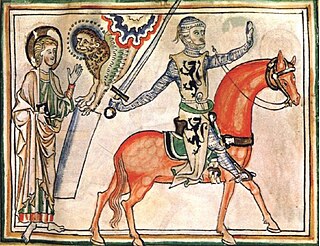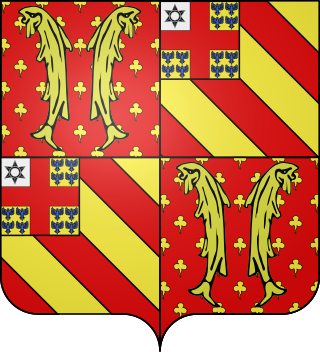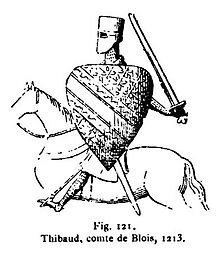
Baldwin I was the first Emperor of the Latin Empire of Constantinople; Count of Flanders from 1194 to 1205 and Count of Hainaut from 1195 to 1205. Baldwin was one of the most prominent leaders of the Fourth Crusade, which resulted in the sack of Constantinople in 1204, the conquest of large parts of the Byzantine Empire, and the foundation of the Latin Empire. He lost his final battle to Kaloyan, the emperor of Bulgaria, and spent his last days as his prisoner.

Henry I, known as the Liberal, was count of Champagne from 1152 to 1181. He was the eldest son of Count Theobald II of Champagne, who was also count of Blois, and his wife, Matilda of Carinthia.

Guy of Dampierre was the Count of Flanders (1251–1305) and Marquis of Namur (1264–1305). He was a prisoner of the French when his Flemings defeated the latter at the Battle of the Golden Spurs in 1302.
Alice of France was countess consort of Blois by marriage to Theobald V, Count of Blois. She was regent of Blois during the absence of her spouse in 1190–1191, and regent during the minority of Louis I, Count of Blois from 1191 until 1197.
The counts of Clermont-en-Beauvaisis first appeared in the early 11th century. Their principal town was Clermont, now in the Oise department but then within the ancient county of Beauvaisis in the province of Île-de-France. Following the death of the childless Theobald VI of Blois, Philip II of France bought the county from his heirs in 1218 and added it to the French crown. It was first granted as an appanage in 1218 to Philip Hurepel; with the extinction of his line, it was granted in 1268 to the House of Bourbon, and was confiscated with the Duchy of Bourbon in 1527.

Theobald V of Blois, also known as Theobald the Good, was Count of Blois from 1151 to 1191.

Louis I of Blois was Count of Blois from 1191 to 1205. He is best known for his participation in the Fourth Crusade and later prominent role in the Battle of Adrianople

Margaret of Blois was suo jure Countess of Blois in France from 1218 to 1230. From 1190 to 1200, she was the countess consort of the County of Burgundy and then regent for her daughters from 1200 until 1208.

Ralph I of Vermandois was Count of Vermandois. He was a son of Hugh, Count of Vermandois and his wife, Adelaide, Countess of Vermandois. Ralph was a grandson of Henry I of France, while Ralph‘s mother had been the Carolingian heiress to Herbert IV, Count of Vermandois.

Philip I, called the Noble, was the margrave of Namur from 1195 until his death. He was the second son of Count Baldwin V of Hainault and Countess Margaret I of Flanders. His paternal grandmother was Alice of Namur.
Marguerite de Sablé, Dame de Sablé, was a French noblewoman and one of the wealthiest heiresses in the counties of Anjou and Maine. She was the eldest daughter of Robert IV de Sablé, and the wife of William des Roches, Seneschal of Anjou, who two years after his marriage to Marguerite became one of the greatest barons in Anjou and Maine, her considerable inheritance having passed to him upon her father's death in 1193.

Guy I of Clermont-Nesle was a Marshal of France, Seigneur (Lord) of Offemont jure uxoris, and possibly of Ailly, Maulette and Breteuil. He might have been a Seigneur of Nesle also, or used the title "Sire of Nesle" due to his family. Difficulties about the seigneurie of Breteuil are present, and the status of Ailly and Maulette in relation to Breteuil.
Raoul I the Red of Clermont was a French nobleman, and Count of Clermont-en-Beauvaisis from 1161 until his death. He was the eldest son of Renaud II, Count of Clermont-en-Beauvaisis, and his second wife and thus a younger half-brother of Margaret of Clermont.
Walter II of Avesnes was lord of Avesnes, Leuze, of Condé and Guise, and through his marriage to Margaret of Blois, he became count of Blois and Chartres. He was the son of James of Avesnes, and Adèle, lady of Guise.
Geoffrey VI (Goeffroy VI) (died 6 February 1250) was a Viscount of Châteaudun. He was the son of Geoffrey V, Viscount of Châteaudun, and Adelicia de Nevers. Although Adelicia's ancestry is not precisely known, she is likely the daughter of William IV, Count of Nevers, and Eléonore, Countess of Vermandois.
Clemence, Viscountess of Châteaudun and Dame de Mondoubleau, daughter of Geoffrey VI, Viscount of Châteaudun, and Clemence de Roches, widow of Theobald VI, Count of Blois.
The House of Clermont is a noble family of the French region of Picardy dating from the 10th century and included both the early counts of Clermont-en-Beauvaisis as well as many Constables of France. The house eventually merged with the House of Nesle with the marriage of Raoul II of Clermont and Gertrude of Nesle. The family is the sometimes referred to as the House of Clermont-Nesle.
Catherine of Clermont was the ruling Countess of Clermont-en-Beauvaisis in her own right in 1191-1213. She was also the Countess of Blois by marriage.

Isabelle of Blois or Elizabeth of Blois was the lady of Amboise by marriage and from 1218 until her death the countess of Chartres in her own right. She founded three Cistercian houses for nuns. Twice widowed, she was succeeded by her daughter, Matilda.











